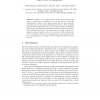Free Online Productivity Tools
i2Speak
i2Symbol
i2OCR
iTex2Img
iWeb2Print
iWeb2Shot
i2Type
iPdf2Split
iPdf2Merge
i2Bopomofo
i2Arabic
i2Style
i2Image
i2PDF
iLatex2Rtf
Sci2ools
CAAN
2004
Springer
2004
Springer
Congestion Games, Load Balancing, and Price of Anarchy
Imagine a set of self-interested clients, each of whom must choose a server from a permissible set. A server’s latency is inversely proportional to its speed, but it grows linearly with (or, more generally, as the pth power of) the number of clients matched to it. Many emerging Internet-centric applications such as peer-to-peer networks, multi-player online games and distributed computing platforms exhibit such interaction of self-interested users. This interaction is naturally modeled as a congestion game, which we call server matching. In this overview paper, we summarize results of our ongoing work on the analysis of the server matching game, and suggest some promising directions for future research.
| Added | 01 Jul 2010 |
| Updated | 01 Jul 2010 |
| Type | Conference |
| Year | 2004 |
| Where | CAAN |
| Authors | Anshul Kothari, Subhash Suri, Csaba D. Tóth, Yunhong Zhou |
Comments (0)

